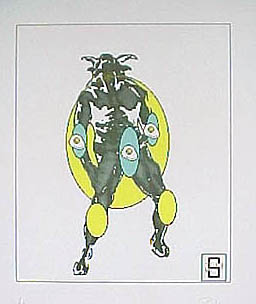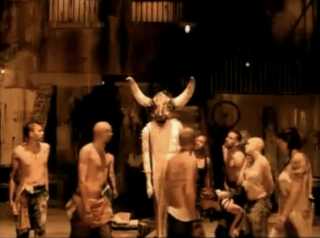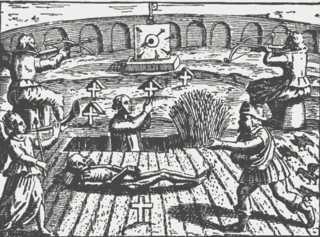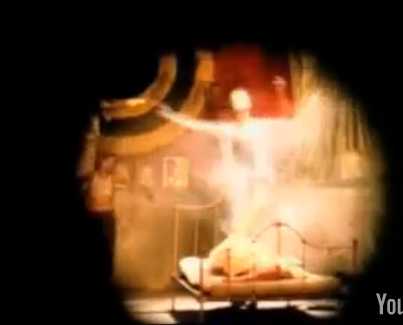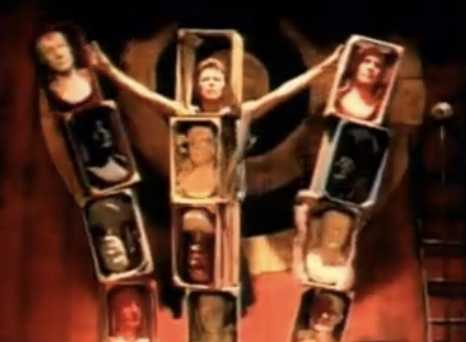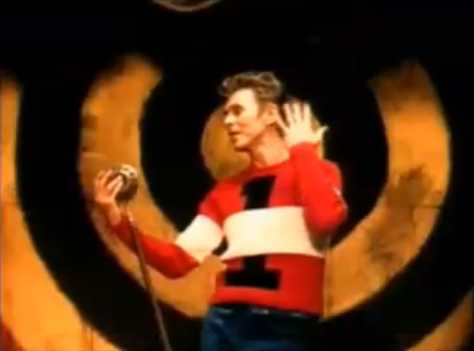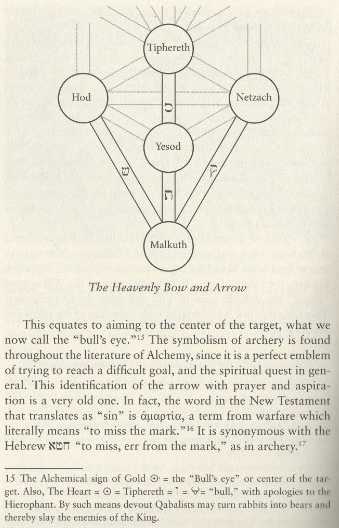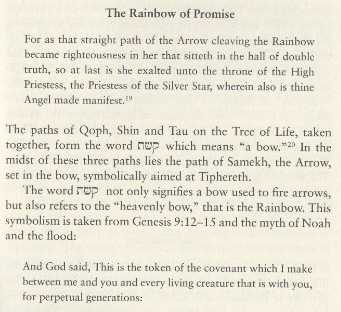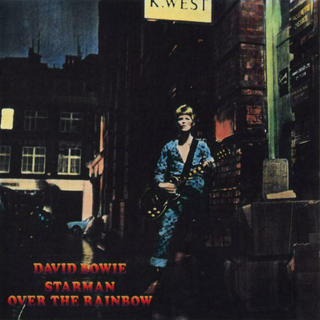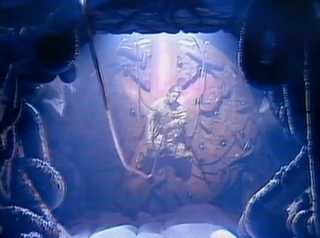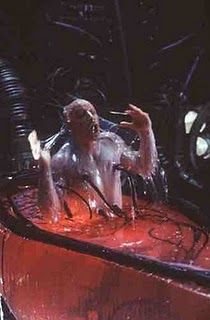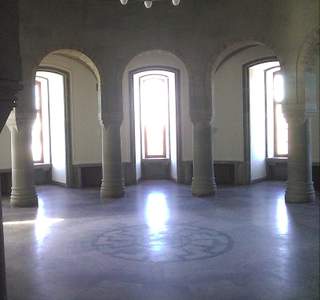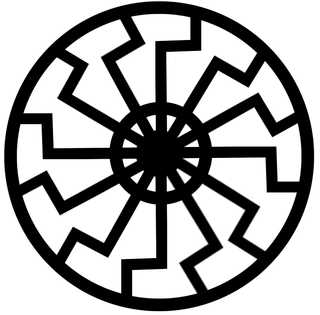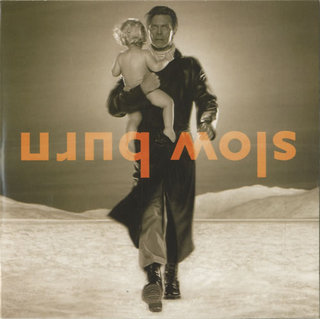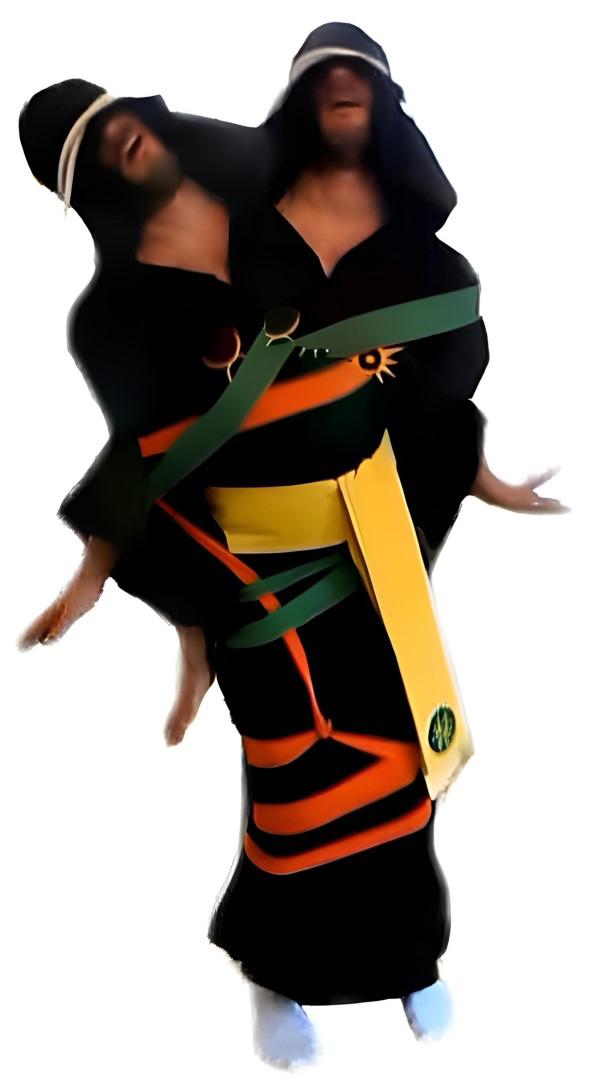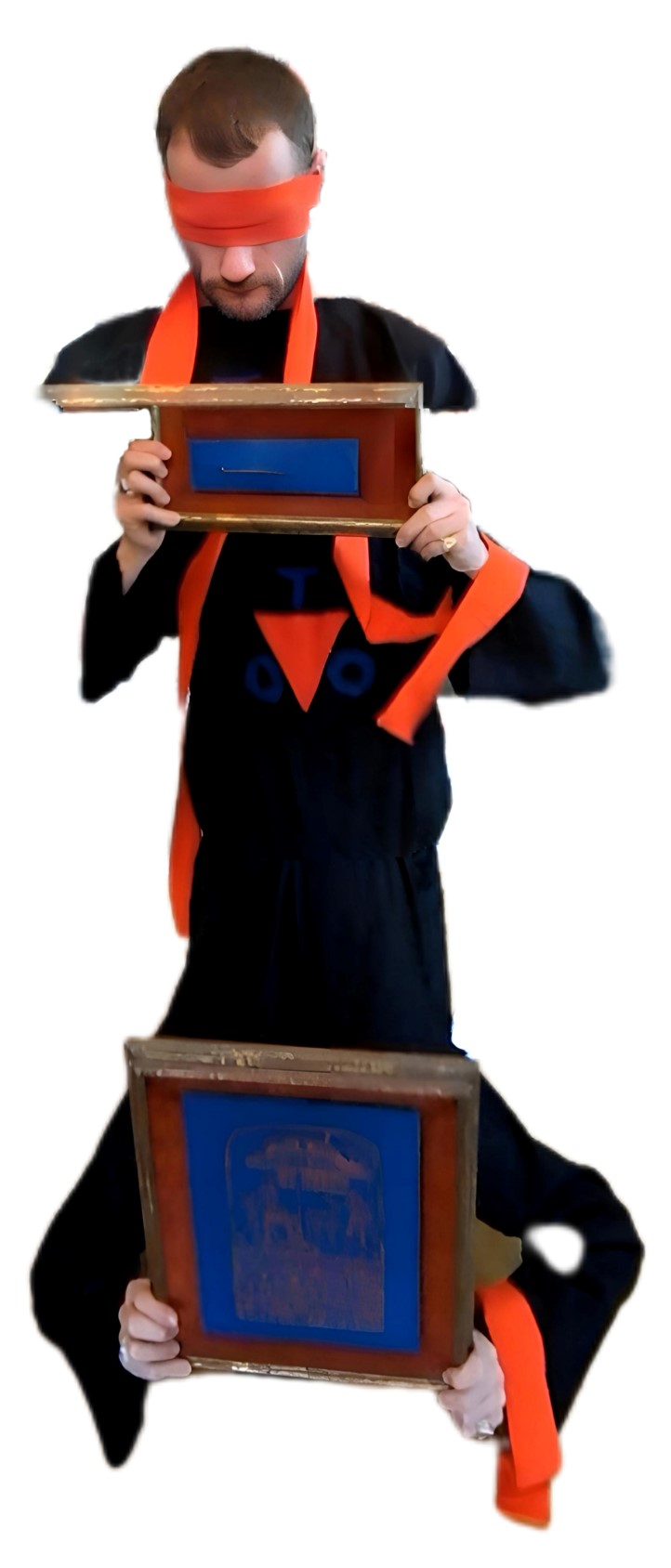David Bowie
|
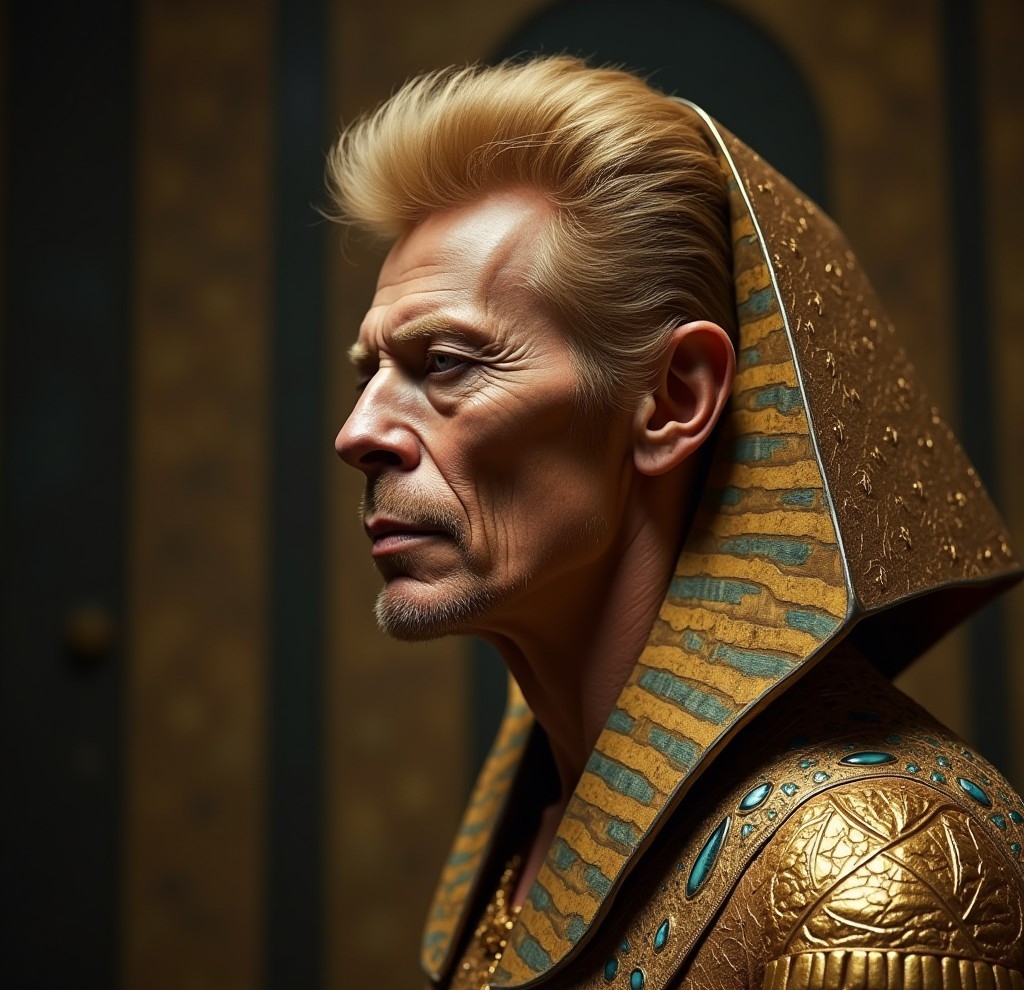
[AI-generated image] |
By Steele Savage[A complement to P.R. Koenig: The Laughing Gnostic — David Bowie and the Occult.] Dalí ... knew exactly what he was doing when he painted his paintings. He knew what all the objects meant.... The attitude that says the artist should paint only things the proletarian can understand, I think, is the most destructive thing possible. (David Bowie, Playboy, 1976) In a 1997 interview, Bowie discussed that the "one continuum" in his songwriting—and Outside in particular—is a search for "spiritual sustenance." I have found over these last few years, that the one continuum that is throughout my writing is a real simple, spiritual search. Everything that I seem to have written, in some way or other, keeps refocusing on the idea that in the late 20th Century, we are without our God. That what we're heading for is an era where we have to completely demobilize our religious organizations and reinvent God in some form or other. We really have to reinvent God. I think that our religious philosophies trail so far behind the way that we actually live today that we find ourselves in a spiritual void, and I think it affects the young very much indeed. I think that that does intervene with Outside in that way. What it does do to resurrect the theme of Outside is that we continually try and find ritual, but we have no religious order to connect that ritual to. Yet we go through the actions of ritualization. We go though pinning ourselves and tattooing ourselves, developing a pagan, tribal kind of authenticity to a religious life that we don't actually have. So we have to reinvent God, I think, in our own new way of life to give ourselves another form of spiritual sustenance. And everything I've written is about "Who is my God? How does he show himself? What is my higher stage, my higher being?" (David Bowie, Music Paper, 1997) It will be seen that David Bowie's 1995 album Outside is an eclectic retelling of the Hermetic Grail Quest—a search for Divine Grace—in a contemporary guise. It effectively serves to bring closure to the whole "nihilistic fantasy world of oncoming doom, mythological characters and imminent totalitarianism" Bowie had constructed in the seventies. Or does it? "ARE YOU RELATED TO SIR PERCIVAL?"According to occultists, humanity's great trauma, shared yet unspoken, has been the primordial death of Love. For the soul, they say, is made of Love; and as a result of its calamitous union with Matter, "such a soul in the present life might be said to die, as far as it is possible for a soul to die" (Thomas Taylor). Such themes have also been expressed in Bowie's work: Soul love — the priest that tastes the word and The vacuum created by the arrival of freedom Bowie's 1995 concept album Outside concerns itself with the investigation of the murder of Baby Grace Blue, with one of the many suspects being Ramona A. Stone, whose name seems to be an allusion to the Philosopher's Stone of alchemy. In Wolfram von Eschenbach's Parzival, the Grail is a Stone. And "the Grail is a symbol of God's grace." The death of Baby Grace is but "the death of Love" itself—and is analogous to the pure swan slain by Parsifal's arrow at the beginning of his initiatory journey. The white swan is (in accordance with Nordic mystical tradition) the symbol of ecstasy, of permanent spiritual delight, that dwells in and dominates the heart and soul of the Graal-Knight, as the highest rapture in whose spell live all inhabitants of Graal-region. (Theodor Reuss) Baby Grace Blue can only be the Babe in the Egg of Blue, Harpocrates, the nascent Silent Self found in the heart—Tiphareth. The alchemists likewise described this as the Christ-Stone. Harpocrates, the "Babe in the Egg of Blue", is described as not only the God of Silence, but as the Higher Self, the Holy Guardian Angel. (Thelemapedia)
[View picture of "The Hanged Man" from another server]
Where can the horizon lie In the Diary of Nathan Adler, written to accompany the album, the mother of Baby Grace is closely associated with mirrors, thereby showing her to represent Nature. Her "diamond-encrusted umbilical cord" is a fitting symbol of the finely-cut Philosopher's Stone. The Philosopher's Stone is an ancient symbol of the perfected and regenerated man … As the rough diamond is dull and lifeless when first removed from the black carbon, so the spiritual nature of man in its "fallen" state reveals little, if any, of its inherent luminosity. Just as in the hand of the skillful lapidary the shapeless stone is transformed into a scintillating gem from whose facets pour streams of varicolored fire, so upon the lathe of the Divine Lapidary the soul of man is ground and polished until it reflects the glory of its creator from every atom. The perfecting of the Diamond Soul through philosophical-alchemical art was the concealed object of Hermetic Rosicrucianism. (Manly P. Hall) Through Nature must be born the Solar Child—but something has gone wrong. At the crossroads of the centuries, Grace has forsaken us. And perhaps Bowie's emphasis on Grace being "fourteen years of age" has more than a little to do with this apocryphal saying of Jesus: He who seeks me, will find me in children from seven years old; for there concealed, I shall in the fourteenth age be made manifest. (Hippolytus, Philosophumena, V) The Black Stone has a peculiar significance in alchemy as the "philosopher's egg," which (in one school of thought, at least) is symbolic of the human heart which, while outwardly blackened by "sin" (restriction), reveals a brilliant golden interior when it is pierced and awakened into a state of Love. (And yet, in another sense, the egg represents the totality of the Self—and herein lies a great Hermetic mystery.) In the alembic of thine heart, through the athanor of affliction, seek thou the true stone of the Wise. (Adeptus Minor Ceremony of the Golden Dawn Thus the lead of the Self becomes gold. And these themes find definite expression on the Outside B-side "Get Real," where humanity is seen as at once spiritual and material: Oh pity us here we angels of lead 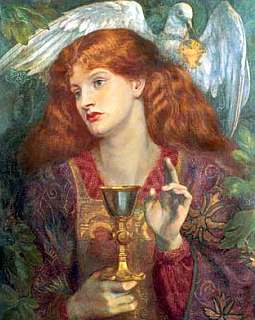
Indeed, it is well known that Bowie had been fascinated by the Grail Quest in the seventies. And curiously, Bowie revealed in a 1976 Playboy interview that the cover of The Man Who Sold the World is a "parody of Gabriel Rossetti," who is known for his works based upon Arthurian romance and the Grail. ... my other fascination with the Nazis was their search for the Holy Grail.... It was this Arthurian need, this search for a mythological link with God.... I was just looking for some answers. Some secret. Some life force. I had this religious fervour. The search for the Holy Grail. (David Bowie, Arena, 1993) In Wolfram von Eschenbach's Parsifal the Knights Templar (Templeisen) are guardians of the Holy Grail. Though Peter-R. Koenig has said that this represents "psychosexual fluids," another common interpretation (as put forth by Emma Jung, Joseph Campbell, and other researchers) is that the Grail is the illuminated heart. This Stone of the Philosophers (Wolfram's Grail) is found on a mountain at the center of the earth. Only the "pure of heart" may attain the Grail—and this is the "heart's filthy lesson." In Crowley's system, ... the mystical ideal [is] the quest to become one with All through the annihilation of the earthly ego ("For as thy blood is mingled in the cup of BABALON, so is thine heart the universal heart."). The blood spilling into the graal of Babalon is then used by her to "flood the world with Life and Beauty" (meaning to create Masters of the Temple that are "released" back into the world of men)... (Wikipedia) Says Mark Stavish [hermetic.com]: Certain schools of yoga as well as kabbalah and Sufi practices view the heart as the center of the individual universe, and the most important of all psychic centers. By opening the heart, we gain access to our Interior Master, or Holy Guardian Angel (messenger) ... This is the final resting place for the Serpents Tongue after its ascent over the skull, and as Boehme and Hermetic imagery have shown, the “Heart girt with a serpent” is the ideal to which mystics aspire. And in Liber 333: As soon as the reason is vanquished, the garotte is removed; then the influence of the supernals (Kether, Chokmah, Binah), no longer inhibited by Daath, can descend upon Tiphareth, where the human will is situated, and flood it with the ineffable light. (Aleister Crowley) Like Wagner's Ring cycle, Outside is billed as part of a "Hyper-Cycle". It is Leon Blank who sets out on the Grail Quest, recalling Bowie's Templar-namechecking "Loving the Alien". Knights who'd give you anything Note that Parsifal is the "Pure Fool," and the Fool Tarot card is attributed to Zero—that is, Blank. Still don't think that Bowie was cribbing from Wagner? Compare this: The youth does not know what the Grail is, but he remarks that as they walk, he seems scarcely to move, yet seems to travel far. Gurnemanz says that in this realm, time becomes space ("Zum Raum wird hier die Zeit"). With "Segue — Nathan Adler": Now Leon Ramona, who has "been dreaming of sleep," has her parallel in Kundry: Kundry herself is now weary for sleep, but cries out that she must not sleep and wishes that she would never again waken. (Wikipedia) But it is important to remember that Bowie is following his own eclectic esoteric interpretation of the Grail legend, rather than its literal text. [Kundry's] outward repulsiveness hides an inner grace and beauty.... Kundry is our own image, the self we dislike because it is so true. And yet, with her help we shall win the Grail. (Rosicrucian Archive) This is to say, Kundry harbors those darker elements the psyche that we must confront before attaining the Grail. And Bowie has never shied away from using his work as a sort of "art therapy," dredging up the most noxious elements of the unconscious in the forms of such characters as the Thin White Duke and Ramona A. Stone, the "tyrannical futurist" whose heart is "so cold." The human spirit is constantly assailed by the mechanized march of dystopian futurism that can only end in "ape men with metal parts." The "cold winter bleeds on the girders of Babel." An axe is needed to break the ice and restore the Wasteland. In "I Have Not Been to Oxford Town," sung by Leon Blank (Parsifal), there is the line: "if I had not ripped the fabric." [Parsifal] can be interpreted as "Pierce-the veil". He is also a Son of a Widow. This is a mystery and is part of the initiatory process. The original Widow in the western esoteric tradition was Isis. At present she is referred to simply as the Goddess. She rules the physical universe and its subtle realms. She appears before the initiate partially covered by a black veil that is the fabric of space and time. (Rosicrucian Archive) Wagner's Parsifal was also quite influenced by the Buddhist idea of the renunciation of desire. And one of the Outside B-sides is ... "Nothing to be Desired!" His reading of the Oriental poets and philosophers led him finally to the pure speculations of pantheism and of Buddhism, the doctrines of which he had adopted long before he discovered their philosophic formula in Schopenhauer's writings. (Maurice Kufferath, The Parsifal of Richard Wagner, p. 182) Said Parsifal in Wagner's drama: Renounce desire; to end thy sufferings thou must destroy their source. (p. 144) ME EXPLODING YOUThe juxtaposition of Crowley's "Art" card with Bowie's 1995 "Heart's Filthy Lesson" painting shows quite conclusively that he had alchemy (the Spagyric Art) on the brain at the time. While many things can be left to the nebulous realm of synchronicity, the painting is unmistakably a deliberate reference to this Tarot card. Is it a coincidence that Outside deals with Art Crime and that this is the 14th card? Who knows! [View Tarot picture of "Art" from another server]
She ... [is] holding the lance which has become a torch and pours forth its burning blood. The fire burns up the water; the water extinguishes the fire.... this is an alchemical allegory. (Aleister Crowley, Atu XIV, The Book of Thoth) "We Prick You" is the most overtly sexual of the songs on Outside, and has as its subject the Holy Spear (i.e., the "prick") of the Grail-mythos. In his opera Parsifal, Richard Wagner identifies the Holy Spear with two items that appear in Wolfram von Eschenbach's medieval poem Parzival, a bleeding spear in the Castle of the Grail and the spear that has wounded the Fisher King. The opera's plot concerns the consequences of the spear's loss by the Knights of the Grail and its recovery by Parsifal. Says Theodor Reuss, The Lance is, admittedly ... the symbol of the phallus. And just the same as one e.g. uses a picture (symbol) Love shoots an arrow (likewise admittedly a symbol of the phallus) at two lovers signifying a request and stimulation of love for a sexual union of the two lovers, thus does the throw of the lance at Parsifal signify that Klingsor wants to compel him to perform a naked act of lust that even as only-a-lust-act again would have been a fall from grace! As Bowie said on The Buddha of Suburbia, "All the great mystic religions put strong emphasis on the redeeming spiritual qualities of sex." The 1993 Arena interview sheds some further light on this: All sex and no romance was the problem.... The human bond was rarely there — another drugs spin-off. Sex becomes a release of energy. All that energy just ends up as sex. Great distinction is made between sex as an act of love and lust. Thus, out on the street, the profane "flesh punks" burn with lust in their "glue." Bowie laments the loss of innocent sexual love—where has pure, spiritual delight—the elusive swan of Parsifal—gone? All the little rose-kissed foxy girls In Wolfram's Parzival, the wounded Fisher King is accompanied by pages and girls garlanded with flowers. There is also a mysterious spear that drips blood—Bowie has simply updated this image by making it a dripping gun. And yet the Spear should not be thought of as the phallus itself, but the subtle energy employed by it. The overriding theme in the occult traditions is that the sexual fire (Lucifer) has a transformative quality; the force both of enslavement and liberation.
It is a question, you see, of pointing out the path to salvation ... which involves a total pacification of the will through love, and not through any abstract human love, but a love engendered on the basis of sexual love, i.e. the attraction between man and woman ... (Richard Wagner to M. Wesendonk, 1 December 1858) There is also a scene where Parzival is entranced by drops of blood in the snow—and in "Wishful Beginnings," the Artist sings, "the pain must feel like snow." Both instances recall the initial act of murder. The Pure Fool becomes enlightened by compassion. THE ANGEL-MANBy cutting "a zero" in the fabric of the veil, Leon is able to cross the abyss. ("In crossing the Abyss the aim is to annihilate the Ego and ... to attain to Zero.") In the song "I'm Deranged," Bowie (as the "Artist/Minotaur") invokes the "Angel Man"—the Holy Guardian Angel, emblematic of the "higher self" centered in the heart/sun. Though it has been claimed that Bowie was inspired by a visit to a community of outsider artists, such an "Angel" also figures in 1979's "Look Back in Anger," when he was still greatly influenced by Crowleyism. And if Koenig isright in saying that Bowie et al. recorded Outside well before visiting the Artist's House at Gugging, this thesis becomes even stronger. It's the angel-man If this union of man and God has homoerotic overtones, it is because in such a Hieros Gamos the soul (psyche) takes on a feminine form and is spiritually impregnated by a masculine deity—the "fist of Love". Directly after the ecstatic union of "Deranged" follows "Thru' These Architect's Eyes," wherein the reborn Master of the Temple returns to the world of men, now ready to "flood the world with Life and Beauty" in a new "Golden Age." The pairing of these tracks is quite suggestive. He has become, so to speak, an embodiment of the Great Architect of the Universe.
"IT'S ALL IN THE EGG"… there is a fifth who is invisible, & therein am I as a babe in an egg. (Liber AL vel Legis, II:49) The "Hearts Filthy Lesson" video features a band of "punks" who ritually dismember a mannequin—obviously meant to represent Osiris-Dionysus, the "Hanged Man". In alchemy, too, as in the Vision of Zosimos, there are frequently acts of dismemberment and disintegration prior to reintegration. What is the "Hearts Filthy Lesson"? It is "death," answers Bowie in the 1995 press kit—the fruit of the Tree of Knowledge.
There is a distinctly sadistic aspect to this card; not unnaturally, since it derives from the Legend of Pasiphae, the prototype of all the legends of Bull-Gods. (Aleister Crowley, The Book of Thoth) There was a sacred bull in this labyrinth, quite white. At the spring festival they sacrificed twelve virgins to him.... They wanted to get a Minotaur, an incarnation of the sun, a Messiah. They said they had one, but they hadn't. (Aleister Crowley, The Paris Working) For I, being a woman, lust ever to mate myself with some beast. And this is the salvation of the world, that always I am deceived by some god, and that my child is the guardian of the labyrinth... (16th Aethyr, The Vision and the Voice) ECLECTIC BLUEWhat has to be decided is: was Bowie working from a Thelemic inspiration in 1995? Note references to losing a "name" (NEMO), invoking an "angel," the "abyss," the "night-filled female," the "Babe in the Egg of Blue," and so on. The lack of an "angel" in the Golden Dawn is what initially led me to think that Bowie has more Crowley influence than he cares to admit. Perhaps he uses those elements which apply to his own Gnostic weltanschauung. Bowie has always said he was a voracious reader, and his search for "spiritual sustenance" seems to be the one thing that he genuinely cares about—so it does not appear that he is merely throwing around images at random. Hungry for Gnosis, his obsession is with self-improvement—but how dedicated was he to the Great Work? But, uniquely linear for a rock artist, he has a library of 4,500 books and also paints and experiments in sculpture. (Fred Hauptfuhrer, People Magazine, September 1976) A fanatical self-improver, who once lugged trunks full of books across the USSR on the Trans-Siberian Express, Bowie is always fascinating for the ways in which he presents to this audience information from outside rock and roll. (Michael Watts, Melody Maker, February 1978) I think and read about it [spirituality] all obsessively. It all tends to become the content of my songs. (David Bowie, Mojo, July 2002) If a direct link cannot be proven, at the very least, Bowie shares certain affinities with Crowley: contempt for organized religion and the weak-minded; adoration of Nietzsche; and most importantly, belief in the imminent arrival of the Aeon of the Child—the "Baby Universal," "Starman," etc. Just a "locator for the Virgin King"? His obsession is with the idea that we need to recreate God—to resurrect that Gnostic Divine Spark—within ourselves. And this is a thread he would find throughout the Western Mystery Tradition. But, looking for sustenance, looking for something outside of ourselves for sustenance, can only lead to depression, I think. We have to find that sustenance within ourselves. (David Bowie, Music Paper, 1997) Bowie constantly namedrops Carl Jung in interviews, who wrote extensively about both alchemy and Gnosticism. It's possible that his fascination with Gnosticism in the mid-nineties arose from this. Indeed, one can find a few traces of Valentinian Gnosticism in Outside if one looks hard enough—Valentinus described the heart as an "inn" in which evil spirits dwelt, while Bowie refers to it as a "laugh hotel". The Valentinians also held that each person had an "Angel," or Higher Self, that one could be united with in the "Bridal Chamber" rite, while Bowie asks his "Angel Man" to "cruise" him. Plus, there are constant references to "flesh punks," "pig men," and "stone boys" that all recall Valentinus' classification of people into spiritual (pneumatic), animal (psychic), and material (hylic). And the first line spoken on the first track of Outside is "Valentine's day." Or is this in reference to the alchemist Basil Valentine? And I would like to point out that he doesn't always say that he no longer has an interest in these things: I'M AFRAID OF AMERICANS So wait, he's putting "black magic" in the same category as "the Beat poets," now? No wonder the Duke is so "afraid of the animals," he doesn't want to get burned at the stake for saying what he really thinks about their slave religions. THROWING DARTS AT DIVINE SYMMETRYThe name Bowie (and also that of the protagonist of Kubrick's 2001, Dave Bowman) is connected with the astrological sign Sagittarius, the Bowman. As an arrow, Sagittarius represents the Will. In Hermetic Qabalah, Sagittarius corresponds to the path of Samekh, connecting the sphere of Yesod to the sphere of the Heart/Sun, Tiphareth. In point of fact, the path of Samekh is also the path of the "Rending of the Veil" (cf. "Parzival"). I do not believe that Bowie was entirely ignorant of these things, as I hope will be proven. The "Strangers When We Meet" video shows a large target—another Sun symbol, ☉.
"It's the process that matters, isn't it? Rather than getting your information — or redemption — easily and directly you must go through this long stubborn painful trek. As with alchemy, the end result isn't as important as the long process whereby all the inessential aspects of "you" have been stripped away..." (David Bowie, "The Resurrection of Saint Dave," Esquire, 1995)
I'm torn between the light and dark The darts motif comes into clearer distinction in the first line of the song "Station to Station": The return of the Thin White Duke, throwing darts in lovers' eyes... J. Daniel Gunther writes in Initiation in the Aeon of the Child (Ibis Books 2009),
In 'Station to Station' there is the line "throwing darts in lovers' eyes". In Crowley's system, the dart or arrow is a symbol of direction, and shows the dynamic of True Will — which is not being but going, not individual but universal.... The "Art" card in Crowley's Tarot (shown above) is attributed to Sagittarius. In a sense, David Bowie himself is the bowman Sagittarius, a personification of fallen humanity reaching for the Heart of the Sun. With the line "from Kether to Malkuth," he may be presenting himself as the Kabbalistic Microprosopus—that is, deus est deus inversus. As revealed in Rolling Stone in 1976, Bowie regarded himself as "the microcosm of all matter." [View Tarot picture of "The Lovers" from another server] The key seems to be in the esoteric interpretation of the "Flaming Sword". The Thin White Duke is the spitting serpent who makes "sure white stains," incarnating Spirit into Matter—the image of the unseen Deity in its most corporeal form. The Man Who Fell to Earth was likewise described as pure spirit who succumbs to materiality. This is the mystery of the Sabbatic Goat who leaps on "mountains and mountains." He is the Redeemer and the Redeemed—"there is no God (or devil) but man." Ego triumphs over the True Will—And what better image of the self-willed tyrant, the figurative Antichrist, than Hitler himself? Consider that "Ziggy" refers to the "zigzag" made by the descending Logos on the Tree of Life from Kether to Malkuth, and that the Duke is not a unique persona but another progression of the Leper Messiah. (That he got the name "Ziggy" from a hat store is plainly ridiculous.) STS then serves to elucidate some of the concepts that he toyed with on ZS. Ziggy became "a little Hitler"—the Fuehrerling. The lightning bolt logo seen in ZS:TMP looks like a Nazi emblem, no? This is also the lightning flash of illumination. Thus he is the Duke Prospero, the Hierophant orchestrating the Hieros Gamos between Heaven and Earth in Shakespeare's Hermetic allegory of The Tempest—"throwing darts in Lovers' eyes." And in 1995 he asks, "who's been wearing Miranda's (the psyche's) clothes?" I think we are due for a revival of God awareness. Not a wishy-washy kind of fey, flower-child thing, but a very medieval, firm-handed masculine God awareness where we go out and make the world right again. (David Bowie, Rolling Stone, February 1976) The overriding theme of Bowie's work is: from here, there is nowhere to go but up. "There is no hell like an old hell, and there is no hell." It is the anguish of the spiritual seeker who realizes how far he has fallen: And once there were sunbirds to soar with Make no mistake, the Duke is a very dark character indeed—though he is a heartless, undead machine, driven only by Will, it is paradoxically Love (Tiphareth) that he most desires, and which most consistently falls through his grasp. "Making love with his ego," the Magus sucks his audience into his magical circle, impregnating their fallow minds with his spermatic Logoi. It's the idea of seeing what you can do with the human persona, how far you can extend the ego out of the body. I think my music is never looked at as just music. (David Bowie, Melody Maker, February 1976) Gunther continues,
They thought K. West must be some sort of code for 'quest'. It took on all these sort of mystical overtones. MOON DUSTIn the video for "Hallo Spaceboy," we find frequent use of love imagery combined with eggs. What is depicted in the video is nothing else than the primordial death of love ("bye bye, love!") that came when the soul fell into matter. Do you want to be free? Break the egg and reveal the sun. To further understand this track, we have to return to Major Tom. The original 1969 "Space Oddity" video saw Major Tom losing contact with Ground Control when he is seduced by Sirens. And that this song has an esoteric interpretation was confirmed by the Major himself: [Spirituality has] been a recurrent qualification of my work from the day I started writing. A very early example, I suppose, is Space Oddity. (David Bowie, Hollywood On Line, 1996) In "Ashes to Ashes," with the line "we know Major Tom's a junkie, strung out on heaven's high," Bowie directly mocks those who think that his songs are just about drugs. The title is from the Book of Common Prayer, in reference to a line from Genesis 3:19 addressed from God to Adam, "for dust thou art, and unto dust thou shalt return." Thus a better explanation is that Major (A)Tom is actually the First Adam. His loss of contact with "Ground Control" is our loss of contact with the Source—or is it the other way around? Now we've found out that he's under some kind of realisation that the whole process that got him up there had decayed, was born out of decay; it has decayed him and he's in the process of decaying. But he wishes to return to the nice, round womb, the earth, from whence he started. (David Bowie, NME, 1980) Decay, of course, is the great limitation of our lives here in the "sphere of generation," where all things are in a constant state of flux. The farther out Major Tom goes, the farther he gets from the Source. Truth is only found when he retreats to the center, as it is there that reality can be transcended. (Leon, too, cut a zero at the "crossroads".) Major Tom, says Bowie, must himself Visita Interiora Terrae and find the Stone.
The starmen that he is talking about are called the infinites, and they are black-hole jumpers.... They just happened to stumble into our universe by black hole jumping. Their whole life is travelling from universe to universe... Now Ziggy starts to believe in all this himself and thinks himself a prophet of the future starmen. He takes himself up to the incredible spiritual heights and is kept alive by his disciples. When the infinites arrive, they take bits of Ziggy to make them real because in their original state they are anti-matter and cannot exist in our world. And they tear him to pieces on stage during the song 'Rock 'n' roll suicide'. As soon as Ziggy dies on stage the infinites take his elements and make themselves visible. As revealed in the song "Ziggy Stardust," Ziggy was not a spider—he was the fly. Ziggy is torn to pieces by the Infinites, who emerge from the dark, anti-matter side of the Tree (the Qliphoth). Dionysus is torn to pieces by the Titans, and from their ashes arise the human race, who is at once divine (Dionysian) and demonic (Titanic). As Mark Dery observes, Ziggy is made of "stars" of the heavens and "dust" of the earth. In the Qabalah and specifically the Golden Dawn system, which Bowie was evidently "closer to" in 1971, it is said that Adam's fall came when something dark and malevolent was unleashed from the Kingdom of Shells (the Qliphoth, again), precisely as happens to Ziggy. After this fall into matter, Adam came under the rule of the astral spheres—"the abode of the evil spirits, the Shells, Envelopes and Cortices of the Kabalah" (A. E. Waite,). It is this darkness of the unconscious which has swallowed up the light of spirit (the mystical heart of Osiris/Dionysus), and from which arises every evil impulse. This "shadow" is in part created by the malevolent astral influences of the sphere of Yesod—the place "where dreams are woven." As the astral plane is also the sphere of the moon (the sublunary realm), it can truly be said of our spaceboy, If I fall, moon dust will cover me. HIMMLER'S SACRED REALM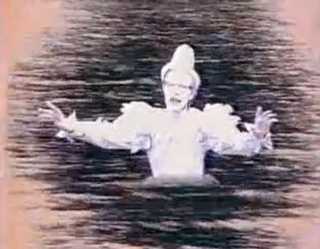
The waters of the subconscious run through all of Bowie's work. The Duke dredges the ocean, lost in his circle; the coked-up Aladdin Sane gazes on the sea; the Pierrot of "Ashes to Ashes" sinks beneath the waves. "Sailor can't dance like you." I'm living in a silent film This is likely another reference to Wagner's realm where "time becomes space". And Bowie claims that he literally opened doorways and walked into other worlds during the seventies, so we may not necessarily take this as lyrical embellishment. I drew gateways into different dimensions, and I'm quite sure that, for myself, I really walked into other worlds. I drew things on walls and just walked through them, and saw what was on the other side! (New Musical Express, 1997) Himmler, for his part, never found the Grail—because as everyone should know by now, Truth is not to be found in the outside world. Himmler came to Montserrat inspired by Richard Wagner's opera Parsifal, which mentions the Holy Grail could be in kept in "the marvellous castle of Montsalvat in the Pyrenees". (The Independent) It was Christ's mission, too, to proclaim that the "Kingdom is within," yet instead they ignored his salvific Gnosis and worshipped the image as God. The sun of the Nazis was not that of righteousness and healing, but the Black Sun of law and wrath.
I'm no longer your golden boy… The Golden Boy is, of course, Hermes/Mercury, the patron god of alchemy. The lesson to learn from Outsider art was that the artist should be primal. Technique or virtuosity didn't matter; that which was unformed and screaming inside of you, waiting to be released, was the real essence of the creativity. (David Bowie, 1995) It is very much a sort of Dionysian entheasm that Bowie is reaching for. And despite his Nietzsche obsession, he has always been "ice masquerading as fire;" the Tin Man/Machine in search of a heart. RAMONA A. STONE
In the Diary of Nathan Adler, Ramona is referred to as the Priestess, which brings us to the High Priestess Tarot card. According to A. E. Waite's system, this card is identified with Binah in Qabalah, the waters. Though she is part of the supernal triad, she is also blackness itself, and associated with Saturn. Saturn is also the "Black Stone" in alchemy. And most significantly, Cybele, the Great Mother of the Greco-Roman Mysteries, was worshipped as a Black Stone. In an anthropomorphic visualization, it may be alternatively related to the "left eye", "left hemisphere" of "the brain" or the "heart." (Wikipedia) Ramona (Mother of Ra?) is the High Priestess who guards the inner adytum, the black goddess whose veil has never been lifted. The Diary records that at the top of her Suicide Temple, the Tree of Life, is the gateway to giving up the Holy Ghost—that is, experiencing Ego Death. "A person who loses a name/Feels anxiety descending." It is too much for him to endure. There's always a diamond friendly Do these lyrics start to make sense, now? Diamonds are a girl's best friend, and laughter is the language of the soul. He is saying that Ramona exists in his soul, in his heart—which is filthy. When he looks within, he finds only a "fantastic daath abyss." He cries out for Paddy—that is, God, the father—to carry him, because he has lost his way. He's already fifty years older, already in his grave, and he still hasn't found himself. I honestly don't know where the real David Jones is. It's like playing the shell game. Except I've got so many shells I've forgotten what the pea looks like. I wouldn't know it if I found it. Being famous helps put off the problems of discovering myself. I mean that. (David Bowie, Playboy, 1976) I suppose we should all shed a single tear for the spiritual plight of a millionaire rock star. Nevertheless, Bowie's own incessant vanity seems to have been a constant source of conflict, as it flies in the face of everything he would've learned about renouncing worldly illusions: Living in the shadow of vanity Whenever Bowie ritually sacrifices an aspect of his ego, there is always another shadow that rises up from the unconscious to take its place. There was a theory that one creates a doppelgänger and then imbues that with all your faults and guilts and fears and then eventually you destroy him, hopefully destroying all your guilt, fear and paranoia. And I often feel that I was doing that unwittingly, creating an alternative ego that would take on everything that I was insecure about. (David Bowie, Arena, 1993) Grappling with the Shadow Self is probably the most consistent theme of his work—"The Man Who Sold the World," "Shadow Man," "Beauty and the Beast," etc. Yet Jung believed that "in spite of its function as a reservoir for human darkness—or perhaps because of this—the shadow is the seat of creativity." In "The Width of a Circle," he sings, "I looked and frowned and the monster was me." I saw myself become something unrecognisable, a monster. And if you are imaginative, it does strike home very hard and leave lots of very definite impressions, indelible images, enigmatic little corners, nooks and crannies with shadows in them that will haunt you for a lifetime.... I was being threatened by my own characters, feeling them coming in on me and grinning at me [his face reddens maniacally], saying 'We're gonna take you over completely!' I thought, 'This is it. Terry, I'm just about to join you.' (Crawdaddy, February 1978) So unless his life has all been one long performance art piece, it's fairly obvious that he always gets lost in the abyss. He is always trying to align himself with the True Will, but never quite gets there. In 2002's Heathen, the sentiment remains: Open up your heart to me Instead of finding catharsis, the Disco King Osiris is still left wandering through the Underworld soundtrack. He spins from Planet X to Planet Aleph, but cannot find rest. The prophet of the coming starmen must have his head removed—"bring me the head of the Disco King." There is "nothing left to release" at the end, and the Dead Man Walking can go no further. WE'LL BUILD A GLASS ASYLUMIn "The Voyeur of Utter Destruction (as Beauty)," we appear to find ourselves once again in the "watery moon" of the unconscious confronting our own personal demons—"the mother's brutal vermin." "Beauty," is, of course, Tiphareth ("stare at the sun"), and the destruction is that of material illusions. 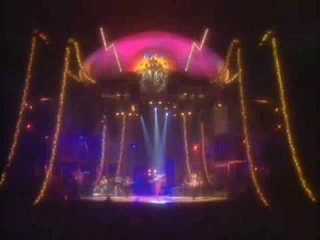
But for now, let's turn to the infamous Glass Spider... People were still curious about those glass spiders. "They're Jungian (Jung was an old German psychologist, like Freud) figures, mother figures. Why do I keep on writing about spiders? I dunno. It's about realizing you can't rely on your parents anymore." Humph. (No.1 Magazine, April 1987) In Jungian symbolism, the mother is a very complex archetype indeed: 'Mother' is an archetype and refers to the place of origin, to nature, to materiality, the womb, the vegetative functions. It also means the unconsciousness, our natural and instinctive life, the physiological realm, the body in which we dwell or are contained; for the mother is also the matrix, the hollow form, the vessel that carries and nourishes, and it thus stands psychologically for the foundations of consciousness... (Carl Jung, The Collected Works: The Practice of Psychotherapy, 1953) Thus we should take another look at the song "Glass Spider": Up until one century ago there lived, Now compare this to the description of the victim in the Diary: The stomach areas was carefully flapped open and the intestines removed, disentangled and re-knitted as it were, into a small net or web and hung between the pillars of the murder-location, the grand damp doorway of Oxford Town Museum of Modern Parts, New Jersey. Note that the two pillars referred to here are Jachin and Boaz, pictured on the High Priestess Tarot card. Its web was also unique in that it had many layers Which mirrors the description of Ramona's Suicide Temple: The top floor rooms were the gateways to giving up to the holy ghost. What is this image that keeps haunting Bowie's work? The spider weaves the original web of illusion. In Ancient Egypt, this was Neith, who "wove all of the world and existence into being on her loom." And it was originally to her that was attributed the phrase I am the things that are, that will be, and that have been. No one has ever laid open the garment by which I am concealed. The fruit which I brought forth was the sun. It also starts to become understandable why "Scary Monsters (and Super Creeps)" was played on the Outside Tour: She had an horror of rooms she was tired you can't hide beat "The Glass Spider had blue eyes"—Binah is blue. Once one begins the Quest, it is almost impossible to turn back. She could've been a killer if she didn't walk the way she do, and she do VISIONS OF SWASTIKAS IN MY HEADDidn't Hitler, aspiring to be an artist/architect, apply to art school and was rejected? Can he then be viewed as the greatest Outside Artist that's ever been, a guy who staged the greatest theater of destruction that's ever been seen, all because of his burning need to express himself? Wasn't he a little bit deranged and out of control? Wasn't he involved with the occult (Angel Man, indeed)? (bewlaysib, TeenageWildlife.com. defunct) In the Diary, Ramona displays decidedly fascistic tendencies: Anti mixed-race posters pasted upon their alter of pop-death icons party people. A zero with no name looks dull-eyed to Ms Stone, the drone that says "In the future, everything was up to itself''. Yea, I remember Ramona. She set herself up as the no-future priestess of the Caucasian Suicide Temple... Note also how Ramona "hates the funny-coloured Englishmen," placing her squarely in the National Front category. And says Crowley, The about-to-be-Black Brother constantly restricts himself; he is satisfied with a very limited ideal; he is afraid of losing his individuality—reminds one of the "Nordic" twaddle about "race-pollution." In short, Ramona represents everything that Bowie hates about himself—she is the Thin White Duke revived, the emotionless Aryan tyrant with a throng of adoring acolytes who hang on his/her every word. The idea that "Hitler was the first rock star" still haunts him. The Saviour Machine is "Telling Lies," all while pleading, "please don't believe in me." And here, too, is Bowie's harshest condemnation of exoteric Christianity: No convictions of assertive saints believed Caucasian way-out tyrannical evoked no images described Christian saints questions no female christian machine believed no work is caucasian assertive saints believed female described christian tyrannical questions R.A. Stone convictions In "Station to Station," the line "the European canon (or 'cannon') is here" refers to the Aeon of Osiris, typified by the Christian religion—and the Thin White Duke himself. (The play on words of "canon"/"cannon" effectively compares Christianity to fascism.) Thus the "stations" are also the Stations of the Cross, through which his crazed fans drive like demons. The Duke is Ziggy embalmed and enthroned, the exoteric image of the Dead Man on the Cross that is but the husk of doctrine. The profane mistake the signifier for the signified. "More idols than realities," said Bowie in 1980, quoting Twilight of the Idols by Nietzsche. People aren't very bright, you know. They say they want freedom, but when they get the chance, they pass up Nietzsche and choose Hitler, because he would march into a room and music and lights would come on at strategic moments. (David Bowie, 1976) It was Plato who also wrote in his Republic that the multitude, which seldom chooses well, will inevitably fall under the sway of a tyrannical despot. Or does Bowie regard himself as a Philosopher King who must take on the guise of a tyrant in order to deliver his salvific Gnosis? It is, after all, "just Pierrot." And when he sings that "it must be love," it comes off like a genuine plea to his audience for an emotional connection. On the Thin White Duke, in 1993, Bowie remarked: The swastika. They took a Buddhist symbol, the Eastern symbol of the sun, and turned it around so it became a symbol of the dark. That intrigued me about the Nazis. Who was the magus? Who was the black magician? So in Bowie's coke-addled mind, he wanted to know who black magicians were. He had probably seen Crowley's references to the "Black Brothers," and turned to this chapter of Magick Without Tears. There he would have seen Crowley refer to Hitler as being the epitome of the "Black Brother"—mentions of the "svastika" and "'Nordic' twaddle about 'race-pollution'" would have confirmed his theories. Then he would see the line about having "shut themselves up in fortresses," hooded and "encamped upon the Sea," and an image would begin to form in his mind. [The Thin White Duke] was the most scary of the lot ... He was an ogre for me.... I found that I'd taken back to England with me a character who was the epitome of everything that it looked like could be happening to England. I saw the National Front and it was obvious to me: There was a Nazi Party in England. Whether or not it was a good thing that I did, I don't know. I believe it was good- the best way to fight an evil force is to caricature it. (David Bowie, Crawdaddy, February 1978) 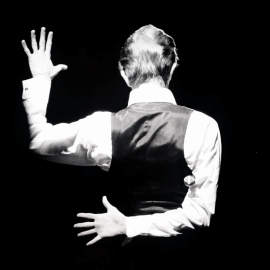
As Bowie has admitted, the Nazi elements of the Duke persona are entirely intentional. Bowie was showing how easily an audience would fall under the spell of a Hitler-figure. The genesis of the idea actually comes from "Somebody Up There Likes Me": That laughter popped up again. One of the most interesting songs on the new album is "Somebody Up There Likes Me," a warning about the danger of hero worship. There is also a continuity between this and Ziggy Stardust that is not always recognized— Edmonds: When you first started doing the Ziggy Stardust character, before it got to the point where you ... But what is truly strange is that he plays the Duke character completely straight. In this very same interview, he goes on about how "Station to Station is probably the first album where I've gotten down to what I really think"! There is no getting around it: Bowie sees his stage persona as Hitler. He is the Super Creep and his fans are groveling slaves, "praying to the light machine." (As Angie pointed out to Peter-R. Koenig, his narcissism is only balanced by his own self-loathing.) And as late as 1996's "Telling Lies," he sings: "Swear to me in times of war and stress." One can sort of see how retiring from music altogether may have been the only way he could keep a clean conscience. "I never said I'm better, I'm better, I'm better, I'm better than you." TRIUMPH DES WILLENSNathan Adler may be named after psychologist Alfred Adler, and I suspect that Bowie considers himself an Adler case file. Adler believed that everyone was driven by the Nietzschean Will-to-Power. Adler ... argued that human personality could be explained teleologically, parts of the individual's unconscious self ideal work to convert feelings of inferiority to superiority (or rather completeness). The desires of the self ideal were countered by social and ethical demands. If the corrective factors were disregarded and the individual over-compensated, then an inferiority complex would occur, fostering the danger of the individual becoming egocentric, power-hungry and aggressive or worse. Can there really be a better description? "I often thought you changed your appearance." I say, "because you didn't like the way you truly looked, that you didn't like yourself." Or perhaps the name comes from the 18th century Jewish Kabbalist Nathan Adler? Do we really have to choose? BEFORE THERE WAS ROCK, YOU ONLY HAD GOD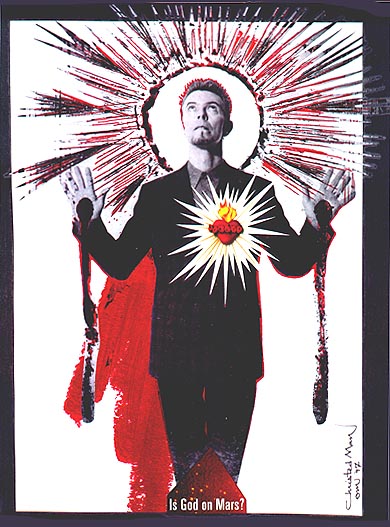
Fans remake themselves in their idol's image by metaphorically tearing him to pieces, like Ziggy in "Rock 'n' Roll Suicide"—obsessively collecting and fetishizing photos, videos, concert memories, celebrity sightings, memorabilia, and other hallowed fragments of the divinity, from which they assemble new, recombinant selves. (Mark Dery, "Leper Messiah: A Jesus Freak's Search for the Meaning of Bowie") In the Diary, Bowie continues to acknowledge his role of Redeemed Redeemer, Osiris-Dionysus, by saying that the supreme act of an artist is to crucify himself. Spurred on by Chris Burdens having himself shot by his collaborator in a gallery, tied up in a bag, thrown on a highway and then crucified on top of a Volkswagen... Joe the Lion nailed himself to a car and told us who we were. The artist—the Pierrot—acts as a mirror. But Bowie has stopped just short of saying what is implicit on the album: for generations of disaffected youths, David Bowie himself had taken over the Judeo-Christian role as Messiah. And this, he must realize, is the greatest blasphemy of them all. You should've never thought us heroes, and you should never honor sewers. The artist doesn't exist. He's strictly a figment of the public's imagination. None of us exist. We're in the twilight zone. We'll all go to hell, 'cause we set ourselves up as gods. (David Bowie, 1972) Yet Bowie also knows that this adoration fills a need. Unfortunately, "you can't stop meaningful teenage cries from deep behind fifty-year-old eyes." My input revolved around the idea of ritual art—what options were there open to that kind of quasi-sacrificial blood-obsessed sort of art form? And the idea of a neo-paganism developing—especially in America—with the advent of the new cults of tattooing and scarification and piercings and all that. I think people have a real need for some spiritual life and I think there's great spiritual starving going on. There's a hole that's been vacated by an authoritative religious body—the judaeo-Christian ethic doesn't seem to embrace all the things that people actually need to have dealt with in that way—and it's sort of been left to popular culture to soak up the leftover bits like violence and sex. (David Bowie in Ian Penman, The Resurrection of Saint Dave, Esquire, October 1995) Somewhat revealingly, but with his tongue planted firmly in his cheek, he said in 1997: I'm a rock god. I'm a single entity who has this incredibly important information that I have to disseminate to the hordes that come and pay homage to me. The most he can hope to do, then, is use his position to its best advantage—to "herald loud the death of man." Bowie, like Ramona, has his acolytes—he has become the Hierophant of the new Aeon, Zarathustra proclaiming the doctrine of the coming Starman to all who will listen. Knowing his Nietzsche fixation, is it a coincidence that "Ziggy Stardust" and "Zarathustra" (also written as Zardust, and in Greek as Zoroaster, which roughly means "stardust")are such similar names? His other great inspiration is mythology. He has a great need to believe in the legends of the past, particularly those of Atlantis; and for the same need he has crafted a myth of the future, a belief in an imminent race of supermen called homo superior. It's his only glimpse of hope, he says — "all the things that we can't do they will." (Melody Maker, January 22, 1972)
A BLACKSTAR ?Then we saw Mishima's dog In the villa of Ormen, in the villa of Ormen In "Blackstar," this refers to the concept of the Heart Girt With a Serpent (= "Ormen"). The solitary candle is the Self as the Divine Spark present in man that is awakened through alchemical processes. The eyes are those of the Goddess, the one Observer. Note here that Bowie disclosed the song was about "Isis," i.e. the Great Goddess, not the terrorist group. "Girl Loves Me." On the day of execution, on the day of execution This refers not to his death, but the esoteric death that comes from crossing the Abyss and immersing oneself in the womb of Binah as Babalon, Sophia, etc. He is called to sacrifice his essential manhood to the Great Goddess in the Hermetic coniunctio. I can't answer why (I'm not a gangstar) This is a reference to the Hanged Man of the Tarot. The spirit of regeneration has been locked in the lowest depths of matter and must be raised back to its proper position in the black heart of man. This is the Heart's Filthy Lesson about the murder of Baby Grace. Bowie seems to have considered his role in Labyrinth to be deeply significant, as the woman pictured in the video seems to be cast as a Jennifer Connelly lookalike; his Anima that will take control of Major Tom's hollow shell and guide him up the Tree. The animal's tail represents the Tarot card Strength. In the next scene, we have visions of a white man, a black man, and a woman--these are parts of his Hermetic conjunctio, the white and black pillars and the High Priestess. Bowie is blinded like the Fool. The skull's image is that of vanitas and the caput mortuum. Beyond the Abyss, there is no more narcissism. The Villa of Ormen becomes the City of the Pyramids. The blackness of the Star is Bowie's own Karma. "In a season of crime, none need atone." But Bowie will pay Her for the crime of ever being the degenerate David Robert Jones at all. At four minutes is when this realization hits; it is the Black Star, Atu 17. Something happened on the day he died This refers to his Crossing the Abyss experience, when he ceased to become David Robert Jones the man, but the Buddha of Suburbia. The blind man's eyes are opened and She winks at him, then nails him to the cross. Bowie becomes the Hierophant crucified on the world stage in the ever-returning mystery. He offers his Book as the black scribblings that veil Her light. The Black Star becomes a woman in black that demands his head—his Ego and everything along with it. "Black struck the kiss, she kept my cock." He must drain every drop of blood into her Grail. The Fool blindly walking the path is the Hierophant is the Magus (The Blind Prophet, The Priest Guy and The Flamboyant Trickster) as the Great Work is undertaken. The Hierophant is always an entity of deception; the Magus joining Kether to Maluth declares, "The European canon is here." I'm dying to The Hierophant is Telling Lies as the people worship him instead of, as Bowie said back in the '70s, reading Nietzsche and becoming supermen. I can't give everything away The fact that people reject his veiled doctrine is why there is no use even trying to explain it. He left this as a message to others in the Temple to show that he was not a pop star, but had already made the great leap into a higher stage of being. Bowie falsely declared that Lorde was the future of music and sealed his death warrant with his final betrayal. © Steele Savage, August 2010 Contact: Email Steele Savage : David Bowie — Outside, Aleister Crowley et le Saint Graal. All Crowley Tarot card pictures are linked from other servers.
|
Read also Peter-Robert Koenig: "The Laughing Gnostic" — David Bowie and the Occult. |
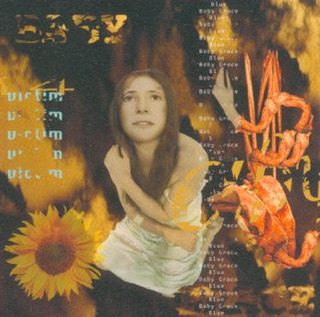

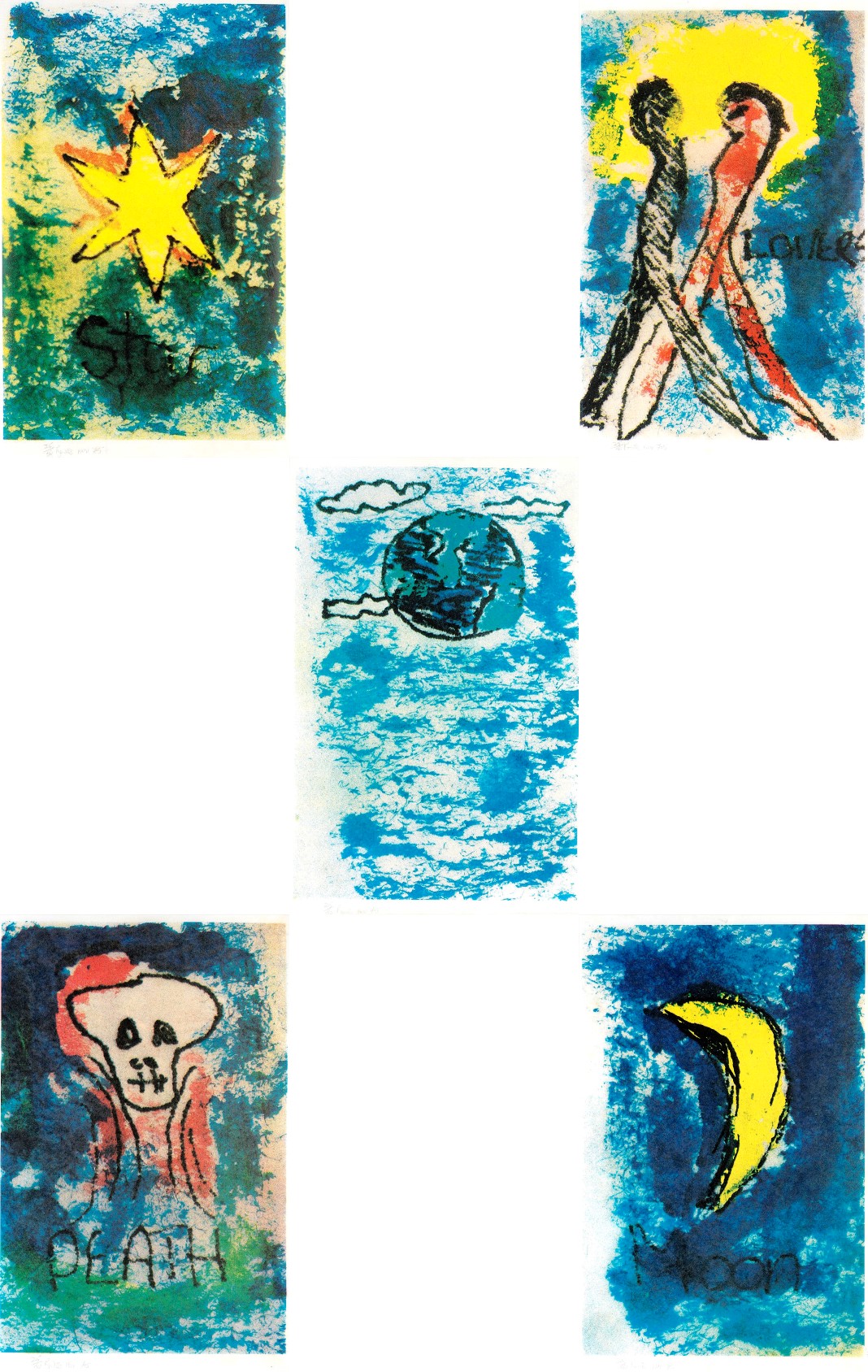
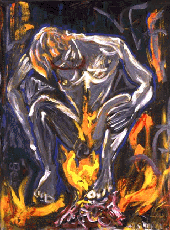
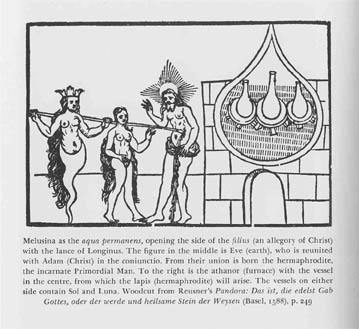
![[linked
image]](https://www.parareligion.ch/2010/bowiegrail_files/kneph.jpg)
